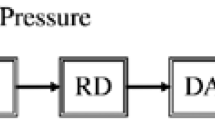The operating principle, advantages and disadvantages of resonator sensors are considered. A method of correcting the additional errors of such sensors is proposed. An experimental investigation of the method on string resonator sensors of linear displacements is described.



Similar content being viewed by others
References
E. A. Kartsev and V. P. Korotkov, Unified String Measuring Transducers [in Russian], Mashinostroenie, Moscow (1982).
Yu. V. Skachko et al., “Features of the use of multimedia computers in frequency-numerical instruments for measuring linear displacements,” Izmer. Tekhn., No. 10, 26-29 (2006); Measur. Techn., 49, No. 10, 991-995 (2006).
Yu. V. Skachko and A. I. Yurin, “Analysis of the effect of vibration on the error of a string resonator,” Izmer. Tekhn., No. 12, 14-16 (2006); Measur. Techn., 49, No. 12, 1189-1193 (2006).
Author information
Authors and Affiliations
Corresponding author
Additional information
Translated from Metrologiya, No. 11, pp. 15–20, November, 2013.
Rights and permissions
About this article
Cite this article
Yurin, A.I., Kartsev, E.A. & Dmitriev, A.V. Methods of Correcting the Additional Temperature Error of Resonator Sensors. Meas Tech 56, 1323–1326 (2014). https://doi.org/10.1007/s11018-014-0375-6
Received:
Published:
Issue Date:
DOI: https://doi.org/10.1007/s11018-014-0375-6




